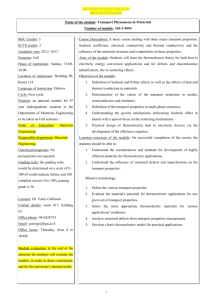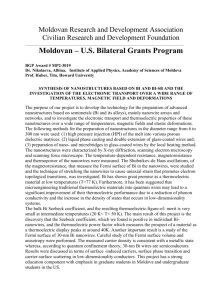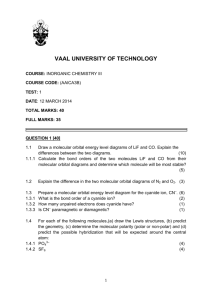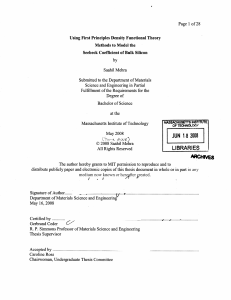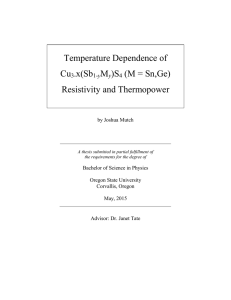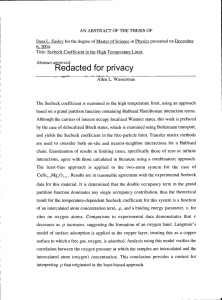Article - I
advertisement
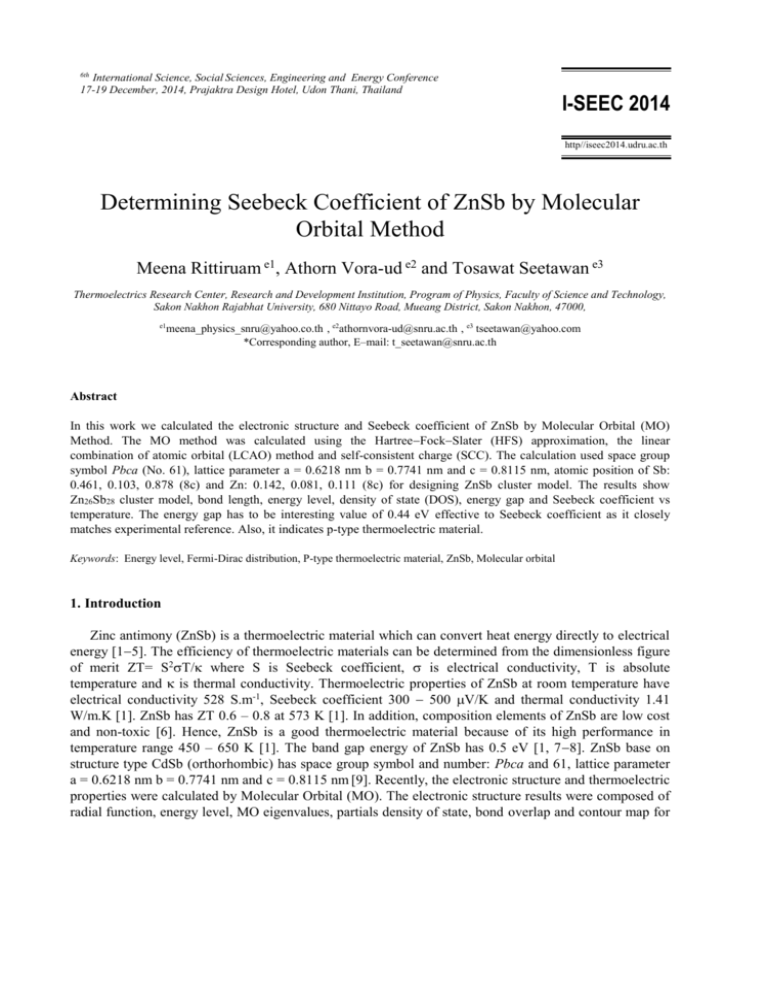
6th International Science, Social Sciences, Engineering and Energy Conference 17-19 December, 2014, Prajaktra Design Hotel, Udon Thani, Thailand I-SEEC 2014 http//iseec2014.udru.ac.th Determining Seebeck Coefficient of ZnSb by Molecular Orbital Method Meena Rittiruam e1, Athorn Vora-ud e2 and Tosawat Seetawan e3 Thermoelectrics Research Center, Research and Development Institution, Program of Physics, Faculty of Science and Technology, Sakon Nakhon Rajabhat University, 680 Nittayo Road, Mueang District, Sakon Nakhon, 47000, e1 meena_physics_snru@yahoo.co.th , e2athornvora-ud@snru.ac.th , e3 tseetawan@yahoo.com *Corresponding author, E–mail: t_seetawan@snru.ac.th Abstract In this work we calculated the electronic structure and Seebeck coefficient of ZnSb by Molecular Orbital (MO) Method. The MO method was calculated using the HartreeFockSlater (HFS) approximation, the linear combination of atomic orbital (LCAO) method and self-consistent charge (SCC). The calculation used space group symbol Pbca (No. 61), lattice parameter a = 0.6218 nm b = 0.7741 nm and c = 0.8115 nm, atomic position of Sb: 0.461, 0.103, 0.878 (8c) and Zn: 0.142, 0.081, 0.111 (8c) for designing ZnSb cluster model. The results show Zn26Sb28 cluster model, bond length, energy level, density of state (DOS), energy gap and Seebeck coefficient vs temperature. The energy gap has to be interesting value of 0.44 eV effective to Seebeck coefficient as it closely matches experimental reference. Also, it indicates p-type thermoelectric material. Keywords: Energy level, Fermi-Dirac distribution, P-type thermoelectric material, ZnSb, Molecular orbital 1. Introduction Zinc antimony (ZnSb) is a thermoelectric material which can convert heat energy directly to electrical energy [15]. The efficiency of thermoelectric materials can be determined from the dimensionless figure of merit ZT= S2T/ where S is Seebeck coefficient, is electrical conductivity, T is absolute temperature and is thermal conductivity. Thermoelectric properties of ZnSb at room temperature have electrical conductivity 528 S.m-1, Seebeck coefficient 300 500 V/K and thermal conductivity 1.41 W/m.K [1]. ZnSb has ZT 0.6 – 0.8 at 573 K [1]. In addition, composition elements of ZnSb are low cost and non-toxic [6]. Hence, ZnSb is a good thermoelectric material because of its high performance in temperature range 450 – 650 K [1]. The band gap energy of ZnSb has 0.5 eV [1, 78]. ZnSb base on structure type CdSb (orthorhombic) has space group symbol and number: Pbca and 61, lattice parameter a = 0.6218 nm b = 0.7741 nm and c = 0.8115 nm [9]. Recently, the electronic structure and thermoelectric properties were calculated by Molecular Orbital (MO). The electronic structure results were composed of radial function, energy level, MO eigenvalues, partials density of state, bond overlap and contour map for 2 predication Seebeck coefficient [10]. In this work, we calculated the electronic structure of ZnSb thermoelectric material by MO method to predict Seebeck coefficient. 2. Computational Method 2.1 MO method The MO method is calculated using the Hartree-Fock-Slater (HFS) approximation, the linear combination of atomic orbital (LCAO) method, and self-consistent charge (SCC) [1113]. The Schrödinger equation is given by; 2 2 Veff (r ) i (r ) Ei i (r ) 2m (1) Veff (r ) Vion (r ) VH (r ) VXC (r ) (2) is molecular wave function, E is energy, m is electron mass, where h / 2 1.054571726(47) 1034 J.s , Veff (r ) is effective potential of the position r can follow by; where Vion (r ) is ion Coulomb potential, VH (r ) is the Hartree potential, VXC (r ) is the exchangecorrelation potential term and is given by the statistical local expression; VXC (r ) 3 [3 / 8 (r )]1/3 (3) where is the only parameter used in this model, the calculation is performed for α = 0.7 by the SCC procedure described below [11]. ( r ) is the molecular electronic density at the position r , and it can be evaluated from; (4) (r ) (, i, j) f Ci* C*j i* (r ) j (r ) where f is the occupation number in the can be written as; th molecular orbital. The (i)Ci i (r ) where Ci is a weighting coefficient, evaluated from; molecular wave function (5) i (r ) is symmetrized LCAO at position r , and can be v i (r ) (v, l, m)Wvmil nlm (rv ) where rv is the coordinate referred to atom group theory and basis function th (6) v , Wvmil is the symmetrization coefficeints obtained from v nlm ( r ) is orbital function centred on the atomic sites, which can be written as; v nlm (r ) Rnlv (r )Ylm (rˆ) (7) v nl where R ( r ) is the radial part of the atomic orbital and generated by numerical computation of atomic problem. The angular part of the atomic orbital Ylm (rˆ) is taken to be real spherical harmonics. 3 2.2 Computational Details The calculation used data of crystal structure of ZnSb such as space group symbol Pbca (No. 61), lattice parameters a = 0.6218 nm b = 0.7741 nm and c = 0.8115 nm, atomic position of Sb: 0.461, 0.103, 0.878 (8c) and Zn: 0.142, 0.081, 0.111 (8c) [9]. This present design cluster model of ZnSb was used to calculate bond length, energy level and density of state. The energy level result give the energy gap (E g) to predict the Seebeck coefficient. The Seebeck coefficient can be evaluated from the Fermi energy (E F) where EF of a semiconductor is one half of Eg. The Seebeck coefficient can be expressed as follows from FermiDirac distribution [14]; 1 f ( E ) k (8) S (T ) B ln e f ( E ) e where S (T ) is the Seebeck coeffcient, k B is Boltzmann constant = 1.3806488(13) 1023 J/K, is electron charge = 1.60217657 1019 C, f ( E ) is Fermi-Dirac distribution function which given by; f ( E ) exp E EF / k BT 1 (9) where E is energy, E F is Fermi energy. The band gap in semiconductors of the order of 1eV, which is much larger than kBT . Therefore; f ( E) exp ( E EF ) / kBT Replacing the FermiDirac distribution function to obtain the Seebeck coefficient; k 1 k S (T ) B ln ( E EF )/ kBT 1 B ln e( E EF )/ kBT ln1 e e e (10) (11) k B ( E EF ) (12) e kBT at T = 0 K, and EF of a semiconductor is one half of energy gap ( Eg ), S (T ) when ( E EF ) EF S (T ) is given by; E S (T ) g 2eT 3. Results and discussion Fig. 1 Zn26Sb28 cluster model (13) 4 Bond lenght order (Å) 5.0 Zn-Zn Sb-Sb Zn-Sb 4.5 4.0 Sb1-Sb7 Sb1-Sb8 Zn1-Zn5 Sb1-Sb2 Zn1-Zn3 Zn1-Zn6 Zn1-Zn4 Zn1-Sb5 Sb1-Sb4 3.5 3.0 Zn1-Zn2 Zn1-Sb2 2.5 Sb1-Sb6 Zn1-Sb3 Zn1-Sb4 Zn1-Sb1 1st 2nd 3rd 4th 5th Number of bonding Fig. 2 bond length of ZnZn, SbSb, and ZnSb in Zn26Sb28 cluster model The Zn26Sb28 cluster model as shown in Fig. 1. Zn26Sb28 cluster model has Ci (1) symmetry and volume 390.604 Å3. The bond lengths of ZnZn, SbSb, and ZnSb are shown in Fig. 2. The first number of bonding, Zn1Sb1 bond length is 2.6709 Å, Zn1Zn2 bond length is 2.8172 Å and Sb1Sb6 is 2.5882 Å in Zn26Sb28 cluster. 2.0 1.8 conduction band 1.6 1.4 1.2 0.8 0.6 0.4 0.2 0.0 -0.2 -0.4 555 ag 555 au 554 au Eg = 0.44(1) eV 554 ag Fermi level 553 au ......................................................................................................... 553 ag 552 ag 552 au valence band Energy (eV) 1.0 -0.6 -0.8 -1.0 Total Zn 3d Zn 4s Zn 4p Sb 4d Sb 5s Sb 5p Fig. 3 Eigenvalues and eigenfunction of valence band and conduction band in energy level of Zn26Sb28 cluster model 5 10 5 0 -5 -10 -15 -20 -25 Zn3d 0 1 2 3 4 5 B 10 5 0 -5 -10 -15 -20 -25 10 5 0 -5 -10 -15 -20 -25 0 1 2 3 4 6 7 8 Sb4d 5 6 7 8 10 5 0 -5 -10 -15 -20 -25 10 5 0 -5 -10 -15 -20 -25 Zn4s 0 1 2 3 4 5 6 7 8 Sb5s 0 1 2 3 4 5 6 7 8 10 5 0 -5 -10 -15 -20 -25 10 5 0 -5 -10 -15 -20 -25 Zn4p 0 1 2 3 4 0 1 2 3 4 5 6 7 0 1 2 3 4 8 Density of State (1/ev unit cell) Fig.4 Density of states for Zn26Sb28 cluster model 800 This work (calculate) C. Okamaru 2010 (experiment) 750 700 650 600 550 500 450 400 350 300 250 300 400 500 600 5 6 7 8 Sb5p Total Seebeck coefficient (V/K) Molecular Orbital Energy (eV) The eigenvalues and eigenfunction of valence band and conduction band in energy level of Zn26Sb28 composed of the total, Zn 3d, Zn 4s, Zn 4p, Sb 4d Sb 5s and Sb 5p as shown in Fig.3. The energy gap is determined from the difference in the valence band and conduction band. In this work an energy gap of 0.44 eV was found, which agrees with the experimental data [1]. Fig. 4 shows the density of state (DOS) of Zn26Sb28, where the total DOS peak is at 7.5 eV. The total DOS of Zn26Sb28 has negative value indicating p-type thermoelectric material agree with literature [15]. 700 Temperature (K) Fig. 5 Calculation of Seebeck coefficient vs temperature of ZnSb 5 6 7 8 6 Seebeck coefficient values of ZnSb together with C. Okamaru et al. [1] are shown in Fig. 5. This result has the Seebeck coefficient of 733 V/K at 300 K. The Seebeck coefficient decreased with increasing temperature and agrees with the experiment of C. Okamaru at temperature range 400 – 570 K. 4. Conclusion The Zn26Sb28 cluster model shows the unit cell of ZnSb. The bond length of Zn1Sb1 is 2.6709 Å. The energy gap of ZnSb is 0.44 eV and DOS of Zn26Sb28 indicated p-type thermoelectric material. Calculation of Seebeck coefficient decreased with increasing temperature agrees with the literature data at temperature range 400–570 K. The molecular orbital (MO) method can be used to calculate the electronic structure of ZnSb thermoelectric material to predict Seebeck coefficient. References [1] T. Ueda, C. Okamura, Y.i Noda and K. Hasezaki. Materials Transactions, Vol. 51, No. 5 (2010) 860862. [2] M. Telkes. U.S patent, 2, 229 (1941) 482. [3] M. Telkes. J. Appl. Phys. 18 (1947) 1116-1127. [4] G.J. Snyder, E.s. Toberer, Nature Master. 7, (2008) 105. [5] See e. g. G. S. Pomrehn, E.s. Toberer, G. J. Synder, A. Vandewalle, phys. Rev. B 83, (2011) 094106. [6] Y. Suga: Thermoelectric Semiconductor, (Maki Shoten, Tokyo, 1966) 314–317. [7] H. Kmoiya et al, Phys. Rev. 133, (1964) A1679. [8] P. J. Shaver, J. Blair, Phys. Rev. 141, (1966) 649. [9] K.E. Almin. ACTA Chemica Scandinavica. 2, (1948) 400407. [10] A. Vora-ud, T. Seetawan and S. Jugsujinda. Chinese Journal Of Physics 50(5), (2012) 868879. [11] H. Adachi, M. Tsukada, and C. Satoko. J. Phys. Soc. Jpn. 45, (1978) 875. [12] T. Tanabe, H. Adachi and S. Imoto. Japanese Journal of Applied Physics. 17(1) (1978) 4958. [13] H. Adachi, S. Shiokawa and M. Tsukada. Journal of the physical society of japan, 47(5) (1979) 15281537. [14] N. F. Mott, E. A. Davis, and R. A. Street. Philos. Mag. 32, (1975) 961996.
